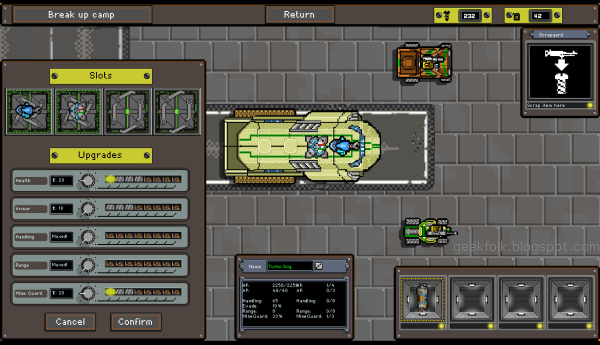When a friend described Convoy to me as “Mad Max meets FTL” it was, obviously, a must play. Somehow, the 2015 release, after a successful Kickstarter campaign, had passed me by unnoticed. Generally, despite the recommendation, I wouldn’t hold a game to another game (or film’s) standards, but Convoy’s Steam page does cite these two greats as influences and I got over-excited. I wish I’d played it with no expectations.
So, scrub off that Furiosa cosplay makeup and let’s discuss what the game is, and not what it isn’t, because it’s actually pretty great. You’re crashed on a complex and brutal world, finding the small collection of components you need to fix your ship. Each has a little description, a location on the world map and a few ways to get it; through amassing wealth, lengthy quest chains or brute force, often to be decided based on the context of the playthrough.
As a rogue-like experience, you should expect to die a lot, at least initially. You must defend your central road train by employing combat fitted cars in real-time, tactical combat. Manoeuvre them within range of enemy vehicles, choose targets, use abilities and be very careful to avoid incoming terrain features that can instantly smash you to smithereens. No seriously. I had nearly won battles without noticing an incoming mesa, only to then lose.
Soon enough, you’ll learn how to upgrade both the truck, which can be made more robust in various ways, and the cars, which can be optimised for firepower, strength, range or manoeuvrability. How you choose to spend scrap on upgrades will influence play style significantly, although you must always endeavour to repair vehicles as a matter of priority. It’s almost impossible to play well enough to take no damage, at least initially.
To me, Convoy is more of an Out There, by Mi-Clos, than a Faster Than Light. FTL is linear, desperate, forward-moving and you can win by a hair’s breadth. In Out There, success relies on your choices leading to an increasingly stronger ship that can withstand bad luck and backtracking. Are you so desperate for fuel you’ll engage any enemies in the hopes of a good return? Are you strong enough to start pillaging everyone close by. The difference is important.
One of the most interesting features of the game is the hex map you travel over. Following roads allows for less fuel to be consumed and greater security in battle. Mountainous hexes require more fuel, but are often significantly more direct. Terrain is coloured red, green or blue to indicate the presence of the planet’s factions. The blue T.O.R.V.A.K, for example, are a tech-rich, but treacherous race you can often avoid and complete quests for, or betray.
The narrative is often really intriguing, but sometimes disappointing. The T.O.R.V.A.K. have a cloaking technology that, in exposition, hints at how to approach their random events. Does it ever truly get explained? Not so far as I’m aware. There are also a lot of pop culture references that detracted from my engagement with story. The ambient storytelling, as well as the potential for player-driven, emergent narrative is strong, but not supported by the explicit dialogues.
Overall, this is an enjoyable experience. Don’t expect FTL or Mad Max. Just smash your cars into other cars so they smash into an immovable object and explode. Consider your options very carefully. Plan a course that always makes you stronger. Decide whether to pay the guy or kill him. Perhaps, in time, you’ll not only have cobbled your spaceship back together, you’ll also have left your mark on this fractious place. Onwards, convoy.

